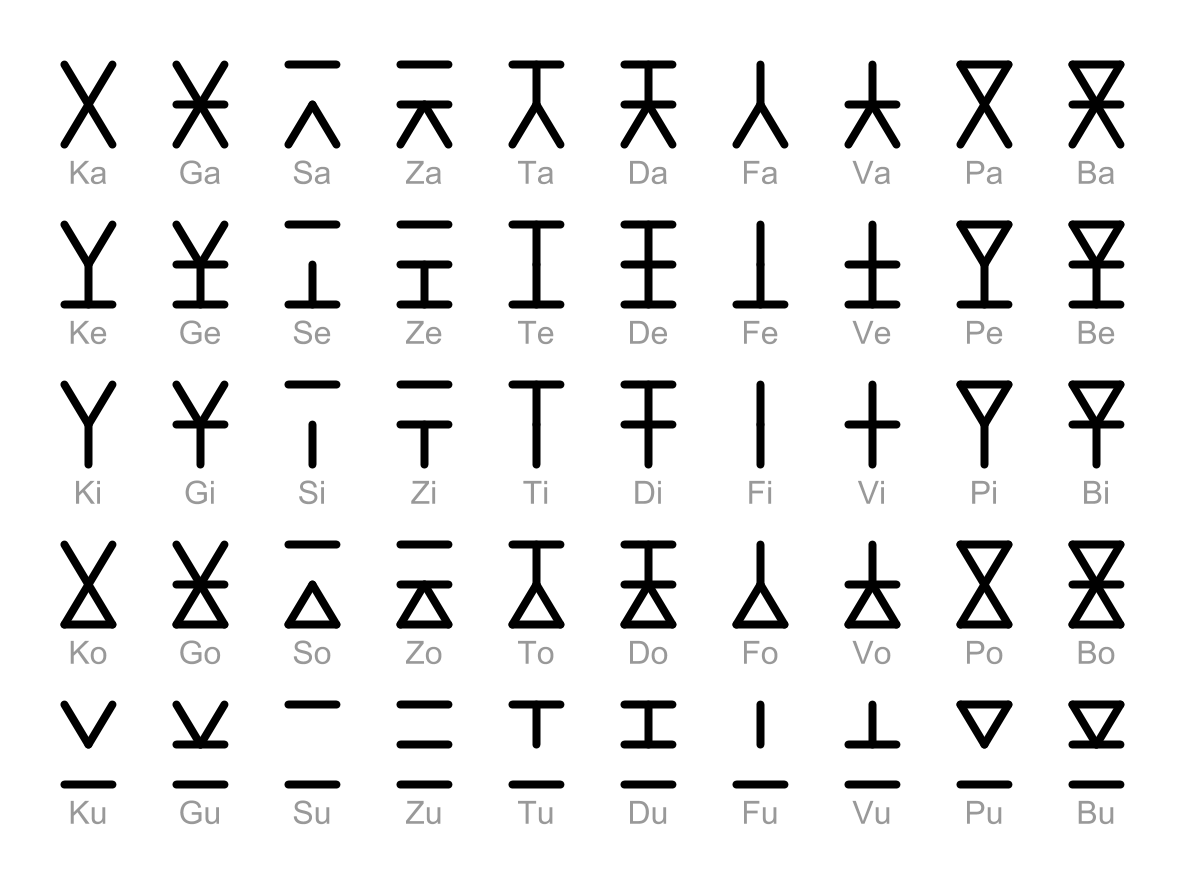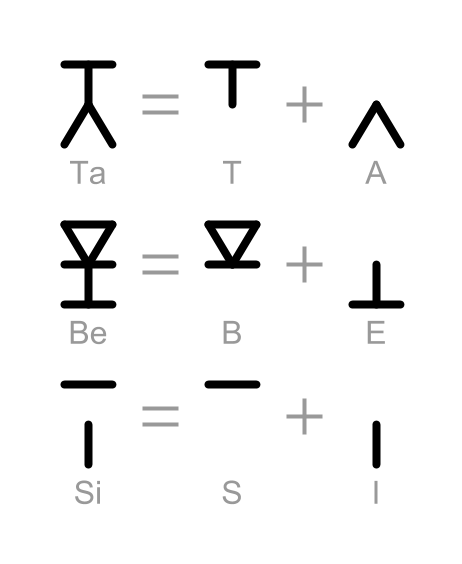= = = LESSON 1 = = =
Phonology and Orthography
Return to Lesson List Return to Main Menu
Before we dive into BreadSpeak grammar and semantics, we should cover pronunciation and spelling. Learning a language is difficult if you cannot read or write it!
BreadSpeak has the same A-E-I-O-U vowel scheme as Spanish and Japanese, which will be familiar if you have studies these languages. The list below shows how to pronounce each vowel:
- A = "a" in "bat" or "pack"
- E = "e" in "bet" or "pen"
- I = "ee" in "beet" or "seem"
- O = "oa" in "boat" or "foam"
- U = "oo" in "boot" or "soon"
I'm not sure if there is a natural language with the exact consonant inventory as BreadSpeak. If there is, please let me know! Regardless, here are the consonants:
- K = "k" in "key" or "kit"
- G = "g" in "get" or "goal"
- S = "s" in "sit" or "soap"
- Z = "z" in "zip" or "zone"
- T = "t" in "tan" or "tool"
- D = "d" in "dot" or "dig"
- F = "f" in "fan" or "fill"
- V = "v" in "van" or "vest"
- P = "p" in "pan" or "pet"
- B = "b" in "ban" or "bowl"
Every BreadSpeak words consists of one or more syllables in a row. Each syllable, in turn, contains exactly one consonant followed by exactly one vowel. Since BreadSpeak has 10 consonants and 5 vowels, there are 50 possible syllables. Here is a nice little table showing all of the possible syllables:
| Ka | Ga | Sa | Za | Ta | Da | Fa | Va | Pa | Ba |
| Ke | Ge | Se | Ze | Te | De | Fe | Ve | Pe | Be |
| Ki | Gi | Si | Zi | Ti | Di | Fi | Vi | Pi | Bi |
| Ko | Go | So | Zo | To | Do | Fo | Vo | Po | Bo |
| Ku | Gu | Su | Zu | Tu | Du | Fu | Vu | Pu | Bu |
The list below shows some example BreadSpeak words, including an approximation of how to pronounce them. This will give you a sense of how the words look and sound:
- Vedo (water) = "veh-doh"
- Ka (cause or create) = "kah"
- Sezu (many) = "seh-zoo"
- Bati (cut) = "bah-tee"
Be careful, because English pronunciation rules do not apply in BreadSpeak! Letters are never silent, and are always pronounced in the same way. For example:
- Fade (bread) = "fah-deh", NOT "feid"!
- Geso (circle) = "geh-soh", NOT "jesso"!
How would you pronounce the BreadSpeak word Sake (possible)?
- "Sah-keh"
- "Say-kee"
- "Seik"
- "Sah-kee"
How would you pronounce the BreadSpeak word Pege (sheep)?
- "Peh-geh"
- "Pee-geh"
- "Peej"
- "Peh-jee"
BreadSpeak has its own script for writing words. In the BreadSpeak writing system, each syllable is just a single character. The image below shows each BreadSpeak character and its Roman alphabet equivalent:

You will probably notice a pattern in the characters. The top half of each character determines the consonant, while the bottom half determines the vowel:

The other feature worth noticing is that all "voiced" consonants contain a horizontal line through the center. "Unvoiced" consonants do not have this line. Every BreadSpeak consonant is part of a voiced/unvoiced pair. Try pronouncing each one while holding a finger next to your throat. You should feel your throat vibrate with voiced consonants:
| Unvoiced | K | S | T | F | P |
| Voiced | G | Z | D | V | B |
These lessons will use the Roman alphabet instead of BreadSpeak script. This is because the Roman alphabet is easier to read for a beginner, and easier to type on a computer. However, if you still want to learn BreadSpeak script, you can use this utility:
There is more structure to BreadSpeak words than random syllables stuck together. For every word containing multiple syllables, the first syllable always has a special meaning. The first syllable gives you a strong idea of the subject matter of the word:
| First syllable | Category meaning | Example words |
| Ta- | Related to time |
Tadu = Year Taso = After Taza = New |
| Pe- | Related to life |
Pepa = Plant Pegi = Healthy Pezo = Breathe |
| Ba- | Related to force |
Bade = Push Babo = Weight Bazu = Strong |
BreadSpeak has twenty of such categories in total. The table above only shows three of them.
The first-syllable mechanism is intended to aid in memorization of words. It can also help you guess the meaning of a word if you've never seen it before.
Which option would you guess is the definition of Peza? Use the table of first syllables above for reference.
- Reptile
- Temporary
- Rock
- Learn
Which option would you guess is the definition of Bafa? Use the table of first syllables above for reference.
- Throw
- Mammal
- Yellow
- Phone
One nifty little feature is that you can easily derive the antonym of any multi-syllable word. (An antonym has the opposite meaning of the original word.) Just perform a vowel change on the first syllable like so:
| Original word | How to form antonym |
| First syllable contains A | Change A in first syllable to U |
| First syllable contains E | Change E in first syllable to I |
The purpose of this antonym derivation is to reduce the number of words to learn. If you memorize the base form of a word, you get the antonym for free! Here are some examples:
| Original word | Antonym |
| Gagi = Good | Gugi = Bad |
| Pago = In front of | Pugo = Behind |
| Zada = Full | Zuda = Empty |
| Gefi = Long | Gifi = Short |
| Sezu = Many | Sizu = Few |
| Feta = Enjoy | Fita = Dislike |
You might be asking yourself, "What happens if the first vowel is O??" Worry not, for BreadSpeak does not have any multi-syllable words whose first vowel is O. This means that EVERY multi-syllable word has a corresponding antonym form. Wow, the creator of BreadSpeak is such a nice guy! ;-)
Now you might be thinking, "Many words don't have antonyms that make sense!" You're right, a lot of BreadSpeak antonyms are incoherent. For example: Zuga = Anti-furniture, and Pipo = Anti-fungus. However, this leaves some room for creativity. For example, you could use Pika (anti-human) to insult your enemies, or Vuse (anti-government) to make a political statement.
The word Taza means "New". Which option would you guess is the definition of Tuza?
- Old
- Month
- Help
- Soap
The word Zeso means "Next". Which option would you guess is the definition of Ziso?
- Previous
- Entire
- Stair
- Name
The word Gati means "Win". How would you say "Fail" in BreadSpeak?
- Guti
- Gata
- Gafi
- Goti
The word Keda means "Hot". How would you say "Cold" in BreadSpeak?
- Kida
- Kedu
- Geda
- Kedi
Congrats, you're done with the first lesson! Just to summarize what you learned:
- BreadSpeak words consist of consonant-vowel pairs.
- The BreadSpeak writing system assigns one character to each syllable.
- The first syllable of a multi-syllable word categorizes the meaning of the word.
- You can derive the antonym of a multi-syllable word by changing the first vowel.